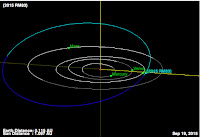Asteroid 2015 TC144 passed by the Earth at a distance of 3 255 000 km (8.47 times the average distance between the Earth and the Moon, or 2.18% of the average distance between the Earth and the Sun), at about 8.35 pm GMT on Thursday 8 October 2015. There was no danger of the asteroid hitting us, though had it done so it would have presented only a minor threat. 2015 TC144 has an estimated equivalent diameter of 25-78 m (i.e. it is estimated that a spherical object with the same volume would be 25-78 m in diameter), and an object of this size would be expected to explode in an airburst (an explosion caused by superheating from friction with the Earth's atmosphere, which is greater than that caused by simply falling, due to the orbital momentum of the asteroid) in the atmosphere between 20 and 1 km above the ground, with only fragmentary material reaching the Earth's surface, although since an object at the upper end of this range would be expected to release an amount of energy equivalent to about 22 megatons of TNT (roughly 1300 times the energy released by the Hiroshima bomb), then being directly underneath it might be fairly unpleasant.
The calculated orbit of 2015 TC144. JPL Small Body Database.
2015 TC144 was discovered on 11 October 2015 (three days after its closest approach to the Earth) by the University of Arizona's Catalina Sky Survey, which is located in the Catalina Mountains north of Tucson. The designation 2015 TC144 implies that it was the 3603rd asteroid (asteroid C144) discovered in the first half of October 2015 (period 2015 T).
2015 TC144 has a 1283 day orbital period and an eccentric orbit tilted at an angle of 3.06° to the plane of the Solar System, that takes it from 0.51 AU from the Sun (i.e. 51% of the average distance at which the Earth orbits the Sun, and between the orbits of Venus and Mercury) to 4.11 AU from the Sun (i.e. 411% of the average distance at which the Earth orbits the Sun, considerably more than double the distance at which the planet Mars orbits the Sun). It is therefore classed as an Apollo Group Asteroid (an asteroid that is on average further from the Sun than the Earth, but which does get closer).
2015 TC144 is also thought to have occasional encounters with other planets, with the most recent such encounters being a close pass of Jupiter in September 2013, and similar encounter with Mercury in December 1941. Asteroid orbits that have close encounters with multiple planets are considered to be quite unstable, as any perturbations can quickly become magnified, throwing the astroid onto a new orbital path.
See also...
Asteroid 2009 TK passed by the Earth at a distance of 6 747 000 km (17.5 times the average distance between the Earth and the Moon, or 4.51% of the average distance between the Earth and the Sun), slightly after 11.50 am GMT on Monday 5 October 2015. There...
Asteroid (445830) 2012 CL19 passed by the Earth at a distance of 6 687 000 km (17.4 times the average distance between the Earth and the Moon, or 4.47% of the average distance between the Earth and the...
Asteroid 2015 RM83 passed by the Earth at a distance of 15 580 000 km (40.5 times the average distance between the Earth and the Moon, or 10.4% of the average distance between the Earth and the Sun), slightly before 6.20 am GMT on Saturday 12...
Follow Sciency Thoughts on Facebook.




